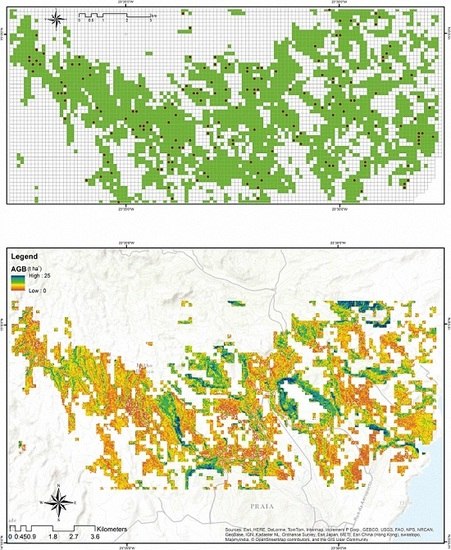Biomass Estimation of Xerophytic Forests Using Visible Aerial Imagery: Contrasting Single-Tree and Area-Based Approaches
Abstract
:1. Introduction
2. Materials and Methods
2.1. Materials
2.1.1. Study Area
2.1.2. Field Data
2.1.3. Aerial photo
2.1.4. Forest Map
2.2. Methods
2.2.1. Single Tree
2.2.2. Area-Based
2.2.3. Wall-to-Wall AGB Spatial Estimation
3. Results
Wall-to-Wall Predictions
4. Discussion
5. Conclusions
- Aerial photography in these specific forest conditions characterized by sparse trees can be used to produce wall-to-wall predictions of forest biomass independently of the approach followed. This is relevant especially for those areas where ALS or high resolution multispectral satellite data are not yet available. Predictions are valid until the tree canopy tends to close. In areas with a denser tree canopy, estimations based on optical data only tend to accumulate higher uncertainty.
- The area-based approach was more accurate than the single-tree method. This is an important finding because this method is also the easiest in terms of image processing complexity and computation time and thus of hardware and software requirements. We noted that when the biomass values to be predicted are lower, the performance of the single-tree approach is higher, but the area-based approach demonstrates a more uniform prediction across the overall biomass range.
Acknowledgments
Author Contributions
Conflicts of Interest
References
- Foody, G.M. Remote sensing of tropical forest environments: Towards the monitoring of environmental resources for sustainable development. Int. J. Remote Sens. 2003, 24, 4035–4046. [Google Scholar] [CrossRef]
- Kumar, L.; Sinha, P.; Taylor, S.; Alqurashi, A.F. Review of the use of remote sensing for biomass estimation to support renewable energy generation. J. Appl. Remote Sens. 2015, 9, 097696_1–097696_28. [Google Scholar] [CrossRef]
- Klinge, H.; Rodriguez, W.A.; Brunig, E.; Fittkau, E.J. Biomass and structure in a central amazônian rain forest. In Tropical Ecological Systems: Trends in Terrestrial and Aquatic Research; Golley, F.B., Medina, E., Eds.; Springer: Berlin, Germany, 1975; pp. 115–122. [Google Scholar]
- Overman, J.P.M.; Witte, H.J.L.; Saldarriaga, J.G. Evaluation of regression models for above-ground biomass determination in Amazon rainforest. J. Trop. Ecol. 1994, 10, 207–218. [Google Scholar] [CrossRef]
- Nelson, B.W.; Mesquita, R.; Pereira, J.L.G.; de Souza, S.G.A.; Batista, G.T.; Couto, L.B. Allometric Regression for Improved Estimate of Secondary Forest Biomass in the Central Amazon. For. Ecol. Manag. 1999, 117, 149–167. [Google Scholar] [CrossRef]
- Henry, M.; Besnard, A.; Asante, W.A.; Eshun, J.; Adu-Bredu, S.; Valentini, R.; Bernoux, M.; Saint-André, L. Wood density, phytomass variations within and among trees, and allometric equations in a tropical rainforest of Africa. For. Ecol. Manag. 2010, 260, 1375–1388. [Google Scholar] [CrossRef]
- Chave, J.; Réjou-Méchain, M.; Búrquez, A.; Chidumayo, E.; Colgan, M.S.; Delitti, W.B.C.; Duque, A. Improved allometric models to estimate the aboveground biomass of tropical trees. Glob. Chang. Biol. 2014, 20, 3177–3190. [Google Scholar] [CrossRef] [PubMed]
- Brown, S.; Lugo, A.E. Biomass of tropical forests: A new estimate based on forest volume. Science 1984, 223, 1290–1293. [Google Scholar] [CrossRef] [PubMed]
- Lehtonen, A.; Mäkipää, R.; Heikkinen, J.; Sievänen, R.; Liski, J. Biomass expansion factors (BEFs) for scots pine, Norway spruce and birch according to stand age for boreal forests. For. Ecol. Manag. 2004, 188, 211–224. [Google Scholar] [CrossRef]
- Segura, M.; Kanninen, M. Allometric models for tree volume and total aboveground biomass in a tropical humid forest in costa rica. Biotropica 2005, 37, 2–8. [Google Scholar] [CrossRef]
- Smyth, C.; Kurz, W.; Neilson, E.; Stinson, G. National-scale estimates of forest root biomass carbon stocks and associated carbon fluxes in Canada. Glob. Biogeochem. Cycles 2013, 27, 1262–1273. [Google Scholar] [CrossRef]
- Rivington, M.; Matthews, K.B.; Bellocchi, G.; Buchan, K. Evaluating uncertainty introduced to process-based simulation model estimates by alternative sources of meteorological data. Agric. Syst. 2006, 88, 451–471. [Google Scholar] [CrossRef]
- Zhang, L.; Yu, G.; Gu, F.; He, H.; Zhang, L.M.; Han, S. Uncertainty Analysis of Modeled Carbon Fluxes for a Broad-leaved Korean Pine Mixed Forest Using a Process-based Ecosystem Model. J. For. Res. 2012, 17, 268–282. [Google Scholar] [CrossRef]
- Lu, D.; Chen, Q.; Wang, G.; Liu, L.; Li, G.; Moran, E. A survey of remote sensing-based aboveground biomass estimation methods in forest ecosystems. Int. J. Digit. Earth 2014. [Google Scholar] [CrossRef]
- Wang, Q.; Adiku, S.; Tenhunen, J.; Granier, A. On the relationship of NDVI with leaf area index in a deciduous forest site. Remote Sens. Environ. 2005, 94, 244–255. [Google Scholar] [CrossRef]
- Leckie, D.G. Advances in remote sensing technologies for forest surveys and management. Can. J. For. Res. 1990, 20, 464–483. [Google Scholar] [CrossRef]
- Greer, J.D. The view from above. J. For. 1993, 8, 10–14. [Google Scholar]
- Holopainen, M.; Lukkarinen, E. Digital Aerial Photographs in Forest Inventory; Department of Forest Resource Management Publications, University of Helsinki: Helsinki, Finland, 1994; Volume 4, pp. 1–33. [Google Scholar]
- Blackburn, G.A.; Milton, E.J. An ecological survey of deciduous woodlands using airborne remote sensing and geographical information systems (GIS). Int. J. Remote Sens. 1997, 18, 1919–1935. [Google Scholar] [CrossRef]
- Tuominen, S.; Haapanen, R. Estimation of forest biomass by means of genetic algorithmbased optimization of airborne laser scanning and digital aerial photograph features. Silva Fenn. 2013, 47, 902. [Google Scholar] [CrossRef]
- Uuttera, J.; Haara, A.; Tokola, T.; Maltamo, M. Determination of the spatial distribution of trees from digital aerial photographs. For. Ecol. Manag. 1998, 110, 275–282. [Google Scholar] [CrossRef]
- Gärtner, P.; Förster, M.; Kurbanb, A.; Kleinschmit, B. Object based change detection of Central Asian Tugai vegetation with very high spatial resolution satellite imagery. Int. J. Appl. Earth Obs. Geoinf. 2014, 31, 110–121. [Google Scholar] [CrossRef]
- Ardila, J.P.; Bijker, W.; Tolpekin, V.A.; Stein, A. Quantification of crown changes and change uncertainty of trees in an urban environment. ISPRS J. Photogram. Remote Sens. 2012, 74, 41–55. [Google Scholar] [CrossRef]
- Ozdemir, I. Estimating stem volume by tree crown area and tree shadow area extracted from pan-sharpened Quickbird imagery in open Crimean juniper forests. Int. J. Remote Sens. 2008, 29, 5643–5655. [Google Scholar] [CrossRef]
- Hirschmugl, M.; Ofner, M.; Raggam, J.; Schardt, M. Single tree detection in very high resolution remote sensing data. Remote Sens. Environ. 2007, 110, 533–544. [Google Scholar] [CrossRef]
- Brochmann, C.; Rustan, Ø.H.; Lobin, W.; Kilian, N. The Endemic Vascular Plants of the Cape Verde Islands, W Africa (Sommerfeltia); Botanical Garden and Museum, University of Oslo: Oslo, Norway, 1997; Volume 24, pp. 1–356. [Google Scholar]
- Černý, M.; Bukša, I.F.; Pasternak, V.P. Usage of Field Technology Field-Map in Forest Management and Nature Protection; Geoinformatics: Kiev, Ukraine, 2006. [Google Scholar]
- Cienciala, E.; Centeio, A.; Blazek, P.; Soares, M.C.G.; Russ, R. Estimation of stem and tree level biomass models for Prosopis juliflora/pallid applicable to multi-stemmed tree species. Trees 2013, 27, 1061–1070. [Google Scholar] [CrossRef]
- Gitelson, A.A.; Kaufman, Y.J.; Stark, R.; Rundquist, D. Novel algorithms for remote estimation of vegetation fraction. Remote Sens. Environ. 2002, 80, 76–87. [Google Scholar] [CrossRef]
- Chirici, G.; Barbati, A.; Corona, P.; Marchetti, M.; Travaglini, D.; Maselli, F.; Bertini, R. Non-parametric and parametric methods using satellite images for estimating growing stock volume in alpine and Mediterranean forest ecosystems. Remote Sens. Environ. 2008, 112, 2686–2700. [Google Scholar] [CrossRef]
- Chirici, G.; Mura, M.; McInerney, D.; Py, N.; Tomppo, E.O.; Waser, L.T.; Travaglini, D.; McRoberts, R.E. A meta-analysis and review of the literature on the k-Nearest Neighbors technique for forestry applications that use remotely sensed data. Remote Sens. Environ. 2016, 176, 282–294. [Google Scholar] [CrossRef]
- Mueller, M.; Segl, K.; Kaufmann, H. Edge-and region-based segmentation technique for the extraction of large, man-made objects in high-resolution satellite imagery. Pattern Recognit. 2004, 37, 1619–1628. [Google Scholar] [CrossRef]
- Adams, R.; Bischof, L. Seeded region growing. IEEE Trans. Pattern Anal. Mach. Intell. 1994, 16, 641–647. [Google Scholar] [CrossRef]
- Shih, F.Y.; Cheng, S. Automatic seeded region growing for color image segmentation. Image Vis. Comput. 2005, 23, 877–886. [Google Scholar] [CrossRef]
- Ball, G.H.; Hall, D.J. A Novel Method of Data Analysis and Pattern Classification; Stanford Research Institute: Menlo Park, CA, USA, 1965. [Google Scholar]
- Wang, G.; Zhang, M.; Gertner, G.Z.; Oyana, T.; McRoberts, R.E.; Ge, H. Uncertainties of Mapping Aboveground Forest Carbon Due to Plot Locations Using National Forest Inventory Plot and Remotely Sensed Data. Scand. J. For. Res. 2011, 26, 360–373. [Google Scholar] [CrossRef]
- Chen, J.M.; Menges, C.H.; Leblanc, S.G. Global mapping of foliage clumping index using multi-angular satellite data. Remote Sens. Environ. 2005, 97, 447–457. [Google Scholar] [CrossRef]
- He, L.; Chen, J.; Pisek, J.; Strahler, A.H. Global clumping index map derived from the MODIS BRDF product. Remote Sens. Environ. 2012, 119, 118–130. [Google Scholar] [CrossRef]
- McRoberts, R.E. The effects of rectification and Global Positioning System errors on satellite image-based estimates of forest area. Remote Sens. Environ. 2010, 114, 1710–1717. [Google Scholar] [CrossRef]
- Breidenbach, J.; Astrup, R. Small area estimation of forest attributes in the Norwegian National Forest Inventory. Eur. J. For. Res. 2012, 131, 1255–1267. [Google Scholar] [CrossRef]
- Tuominen, S.; Pitkänen, J.; Balazs, A.; Korhonen, K.T.; Hyvönen, P.; Muinonen, E. NFI plots as complementary reference data in forest inventory based on airborne laser scanning and aerial photography in Finland. Silva Fenn. 2014, 48, 983. [Google Scholar] [CrossRef]
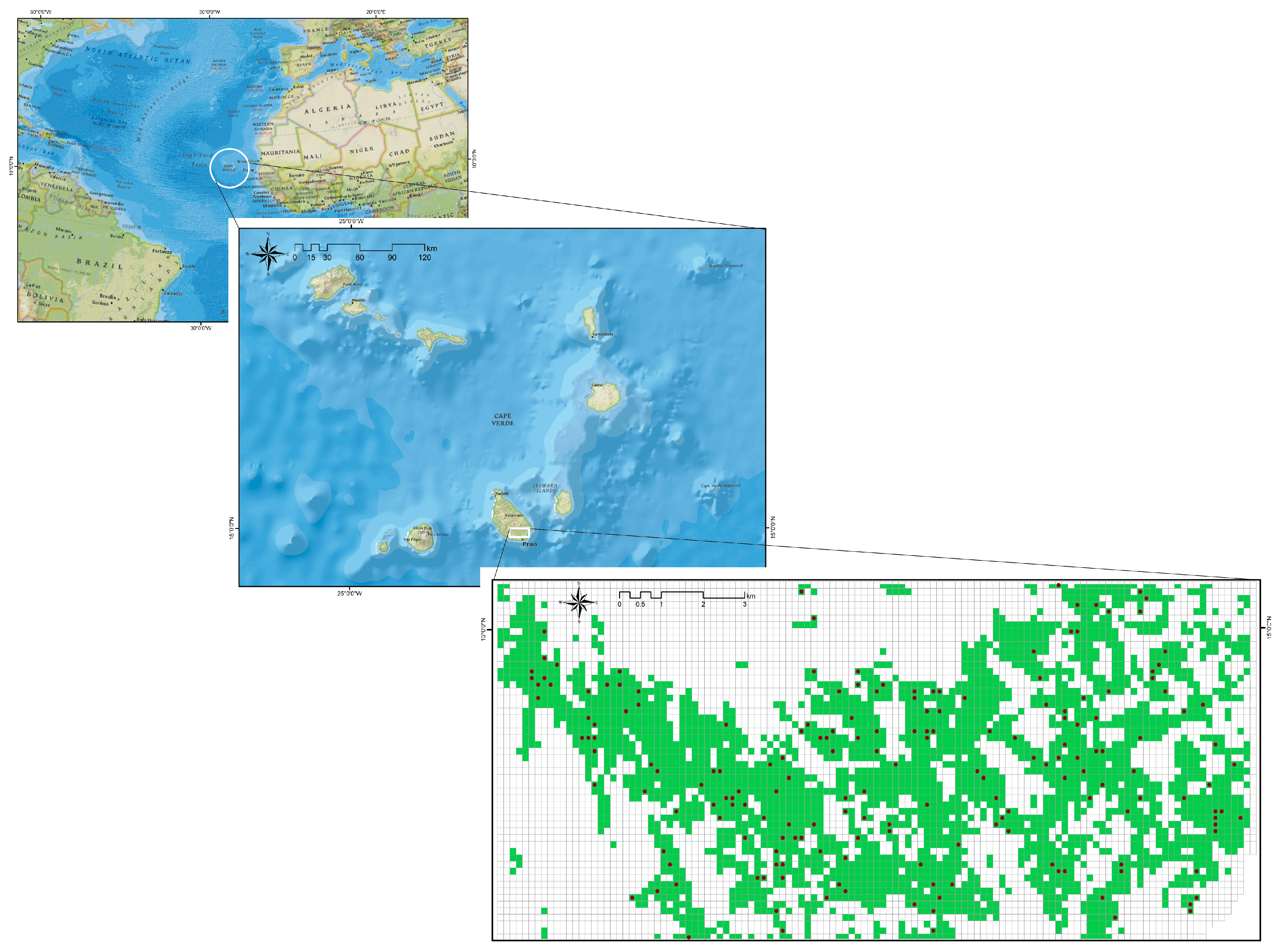
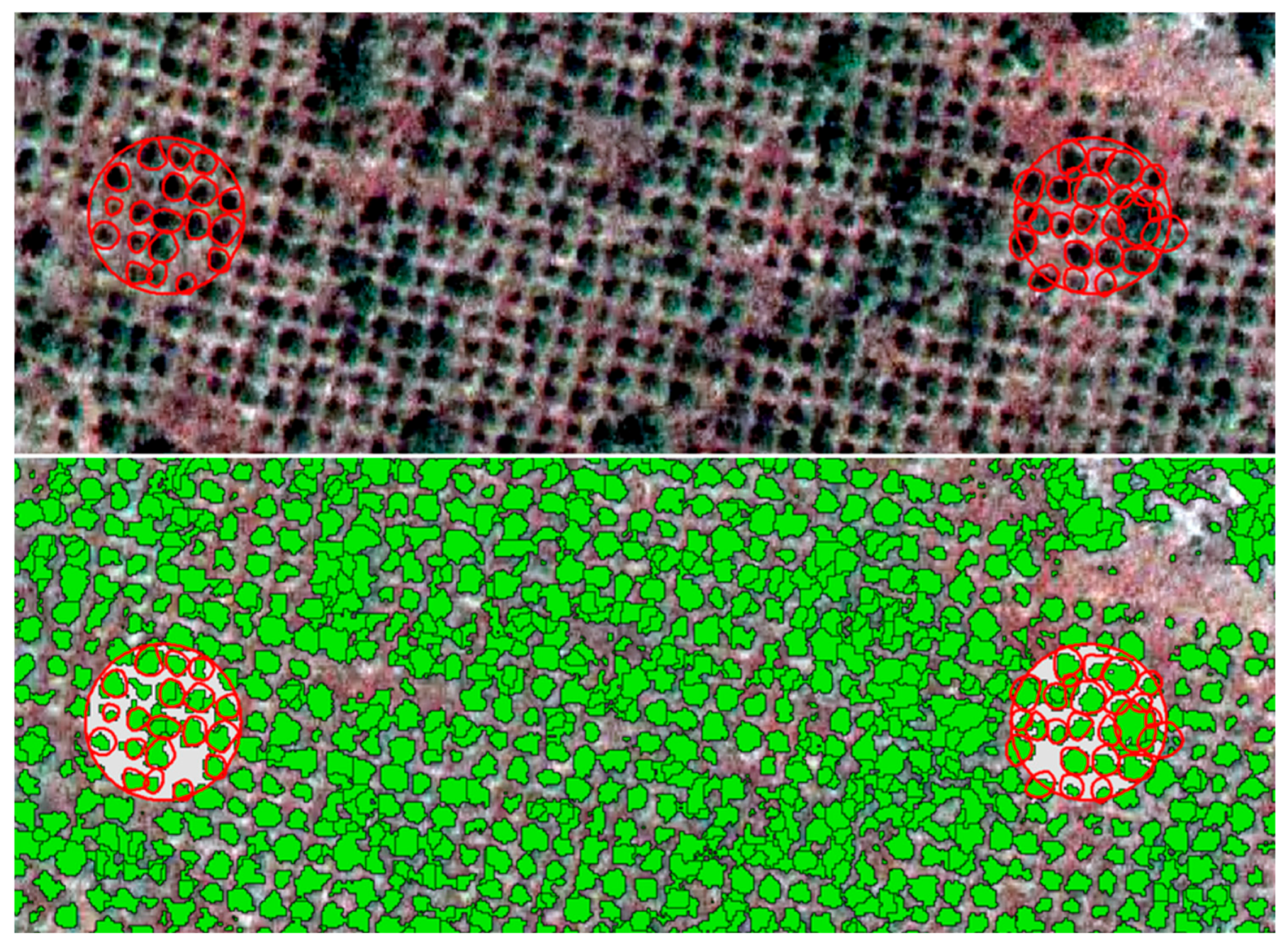
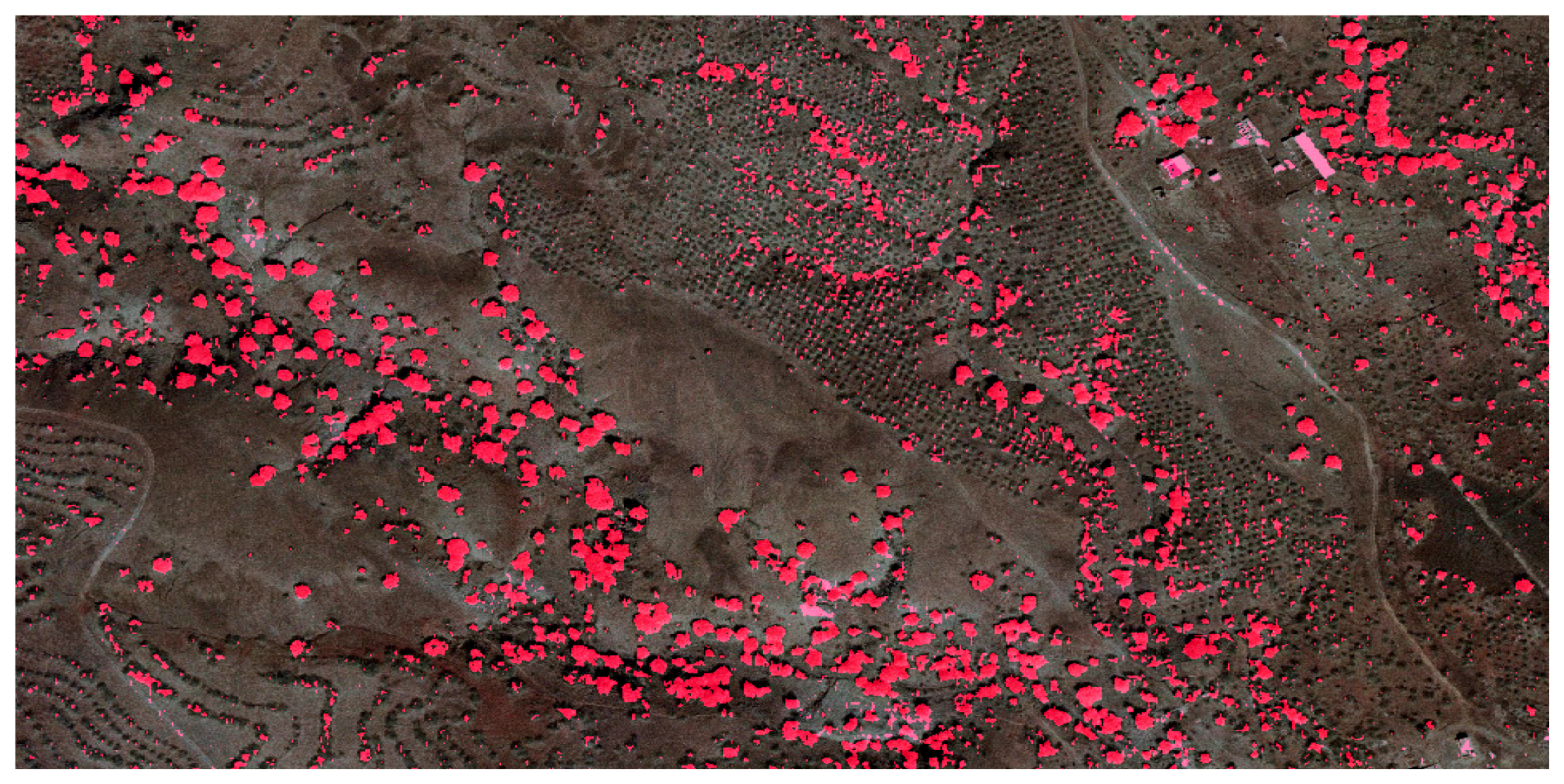
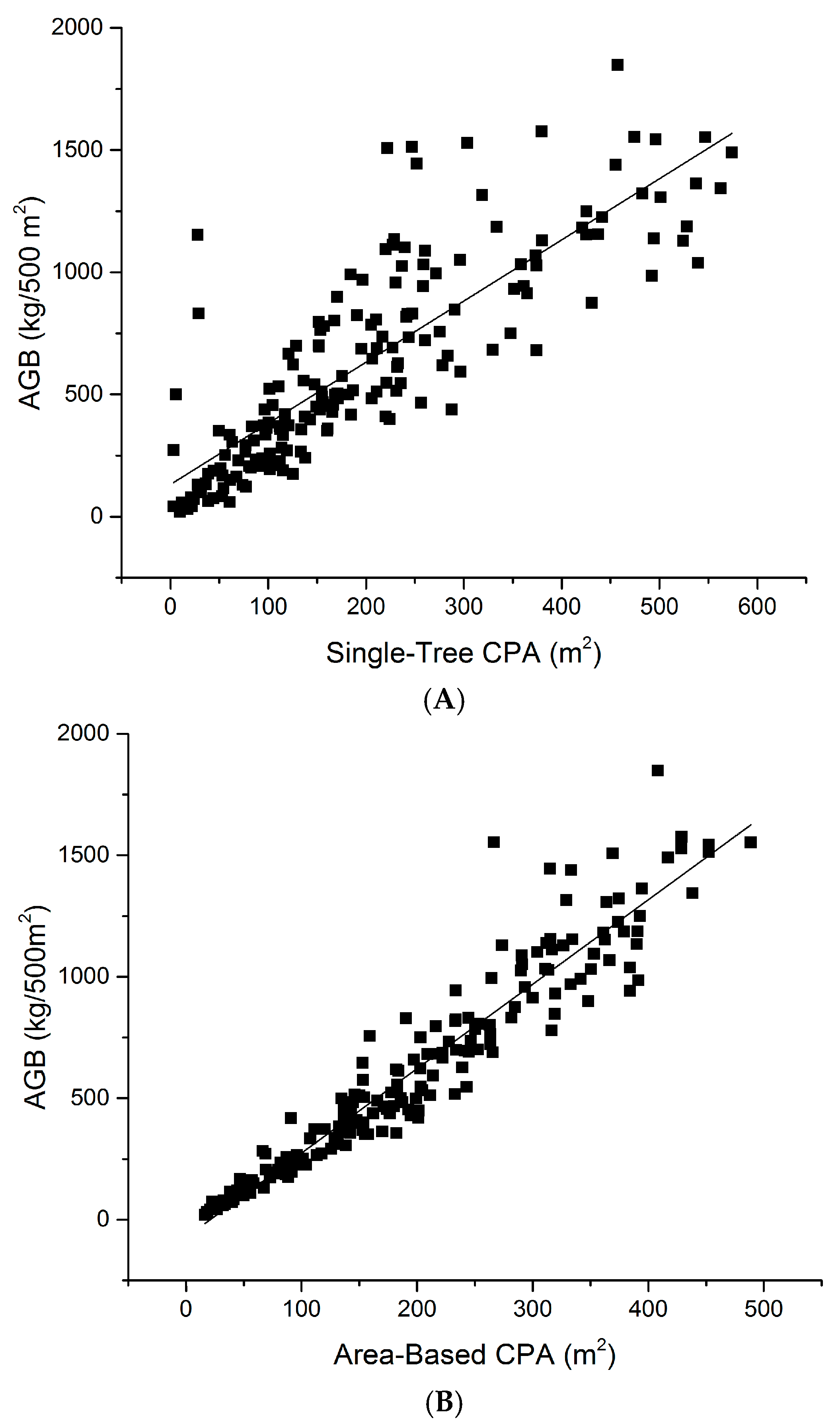
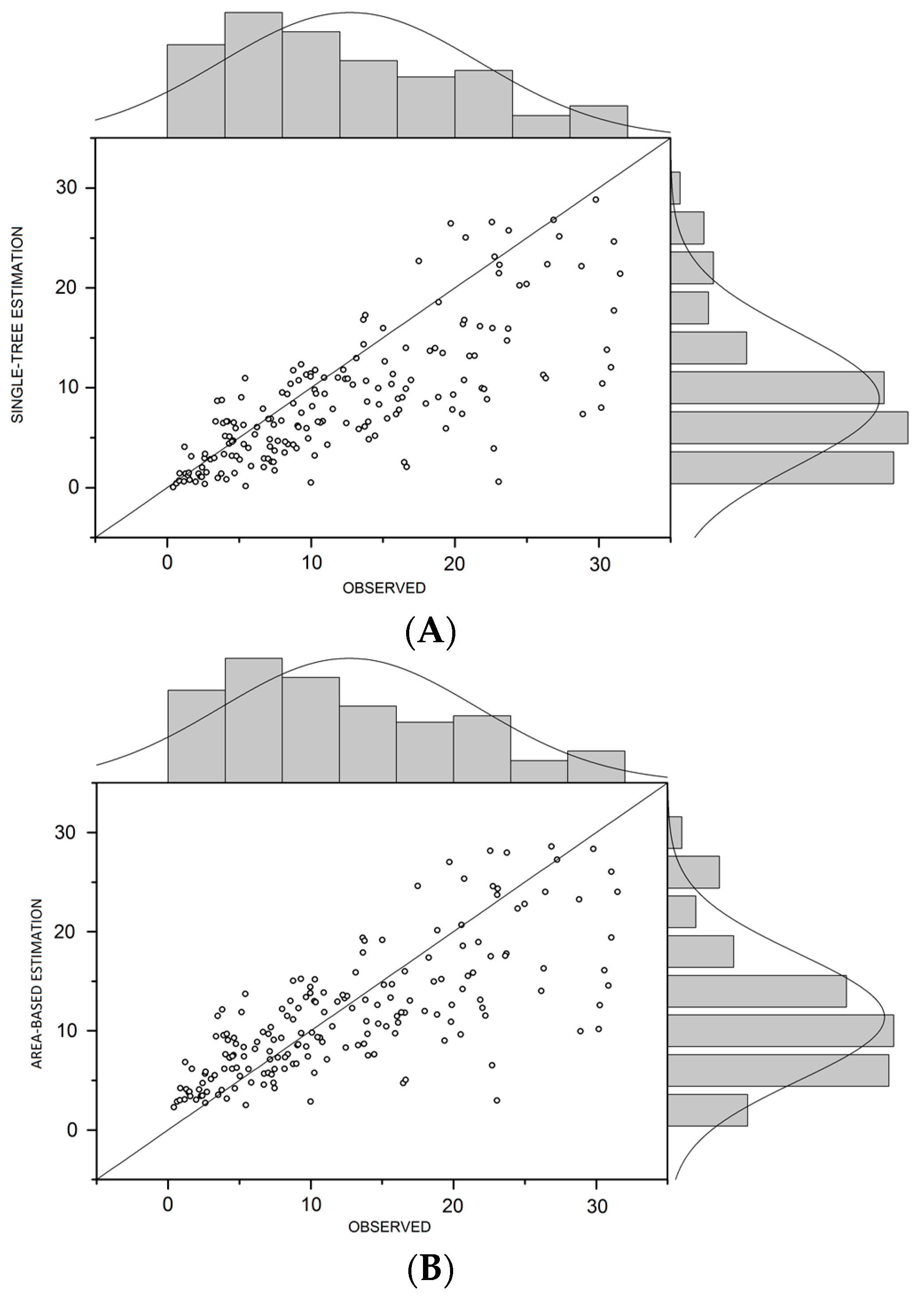


| Radiometric and Spectral Resolution | Natural Colour (RGB) 24-Bit Colour (3 × 8 Bits Per Band) Red, Blue, Green |
|---|---|
| Horizontal accuracies | ±3 pixels |
| Sensor information | Analogic camera |
| Image width, height (pixels) | 100,000 × 125,000 |
| Ground sample distance (GSD) | 0.4 × 0.4 m |
| Sun angle | >40° |
| Fly altitude | 3800 m |
| Source | Geodata Air S.A. |
| Single-Tree | Area-Based | |||
|---|---|---|---|---|
| Intercept | 131.79 | SE = 29.69 | −72.56 | SE = 19.48 |
| Slope | 2.50 | SE = 0.128 | 3.47 | SE = 0.084 |
| Pearson | 0.83 | 0.95 | ||
| Adj. R-Square | 0.70 | 0.90 | ||
© 2017 by the authors. Licensee MDPI, Basel, Switzerland. This article is an open access article distributed under the terms and conditions of the Creative Commons Attribution (CC BY) license (http://creativecommons.org/licenses/by/4.0/).
Share and Cite
Bernasconi, L.; Chirici, G.; Marchetti, M. Biomass Estimation of Xerophytic Forests Using Visible Aerial Imagery: Contrasting Single-Tree and Area-Based Approaches. Remote Sens. 2017, 9, 334. https://doi.org/10.3390/rs9040334
Bernasconi L, Chirici G, Marchetti M. Biomass Estimation of Xerophytic Forests Using Visible Aerial Imagery: Contrasting Single-Tree and Area-Based Approaches. Remote Sensing. 2017; 9(4):334. https://doi.org/10.3390/rs9040334
Chicago/Turabian StyleBernasconi, Luca, Gherardo Chirici, and Marco Marchetti. 2017. "Biomass Estimation of Xerophytic Forests Using Visible Aerial Imagery: Contrasting Single-Tree and Area-Based Approaches" Remote Sensing 9, no. 4: 334. https://doi.org/10.3390/rs9040334
APA StyleBernasconi, L., Chirici, G., & Marchetti, M. (2017). Biomass Estimation of Xerophytic Forests Using Visible Aerial Imagery: Contrasting Single-Tree and Area-Based Approaches. Remote Sensing, 9(4), 334. https://doi.org/10.3390/rs9040334






